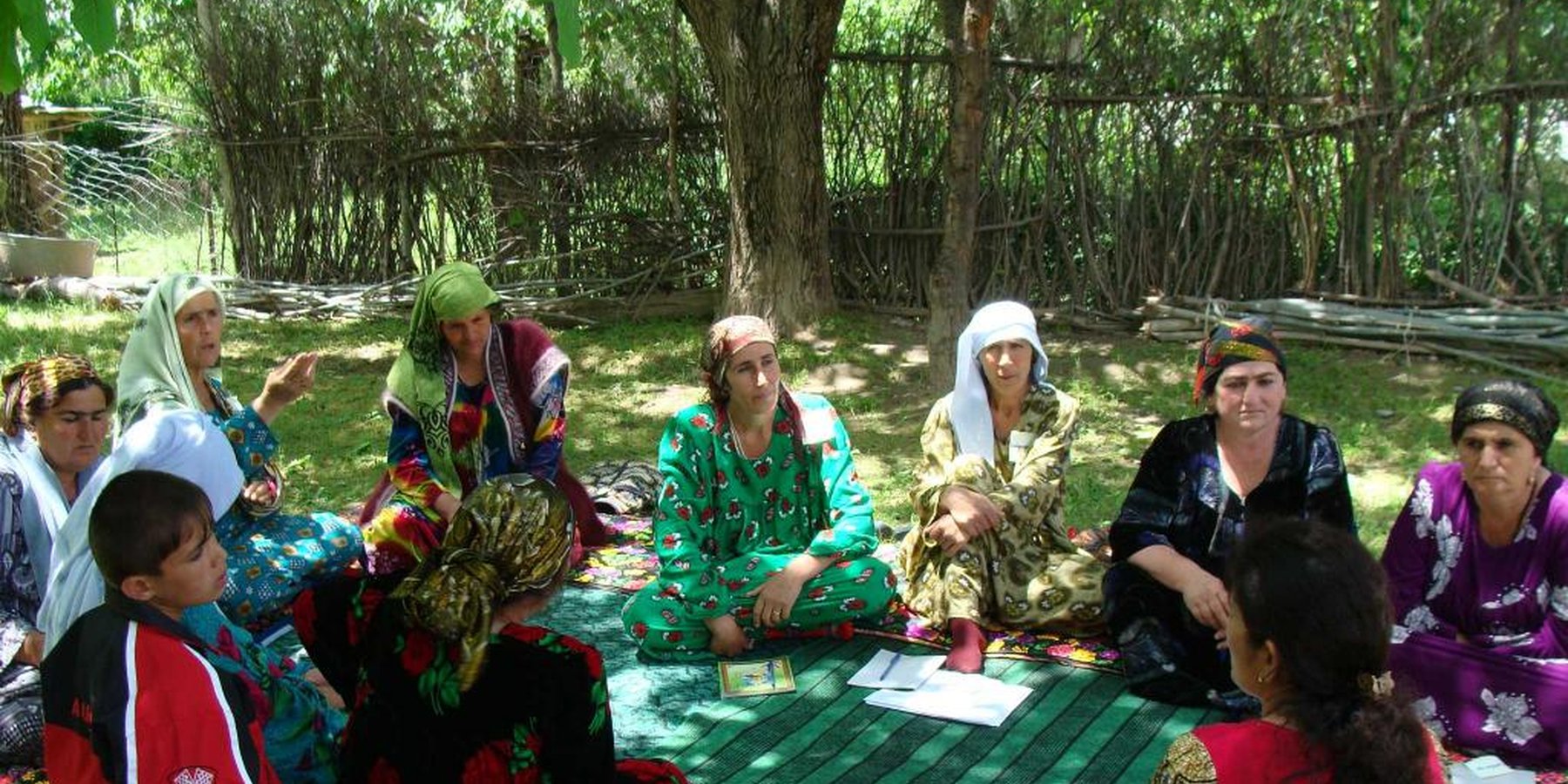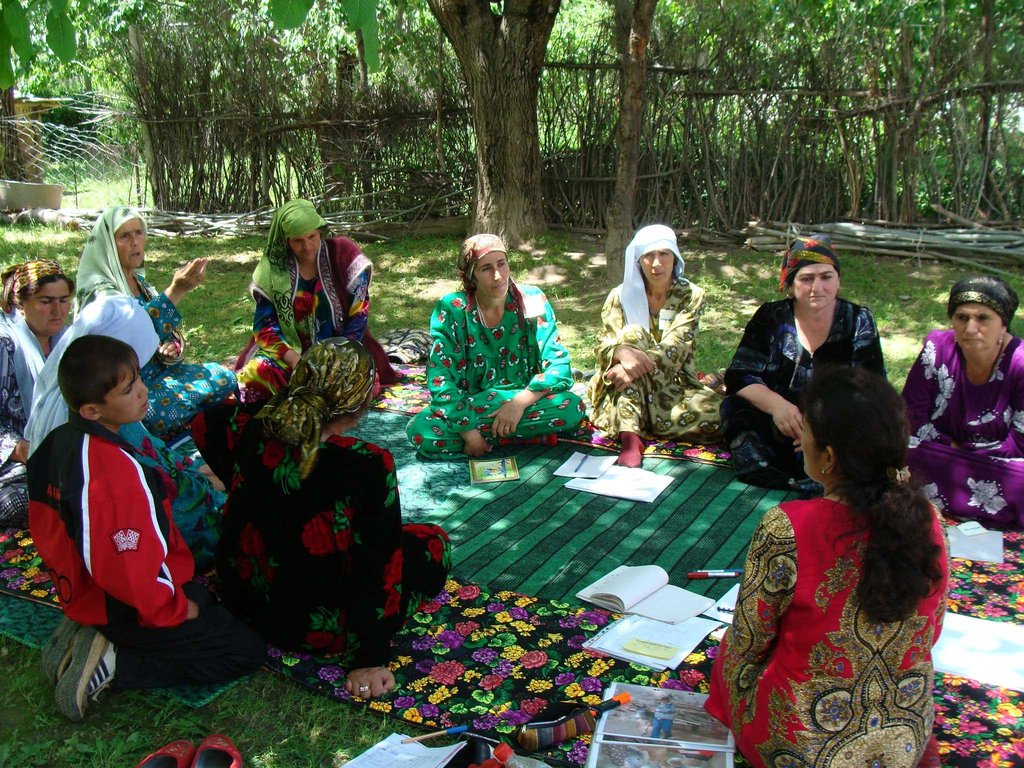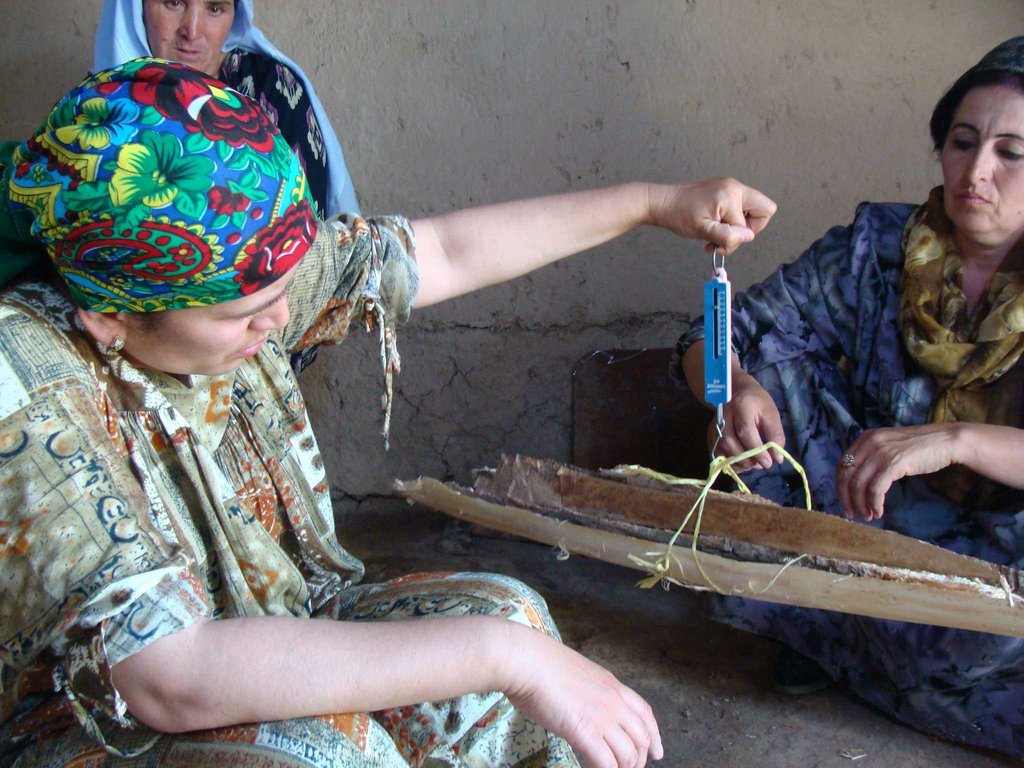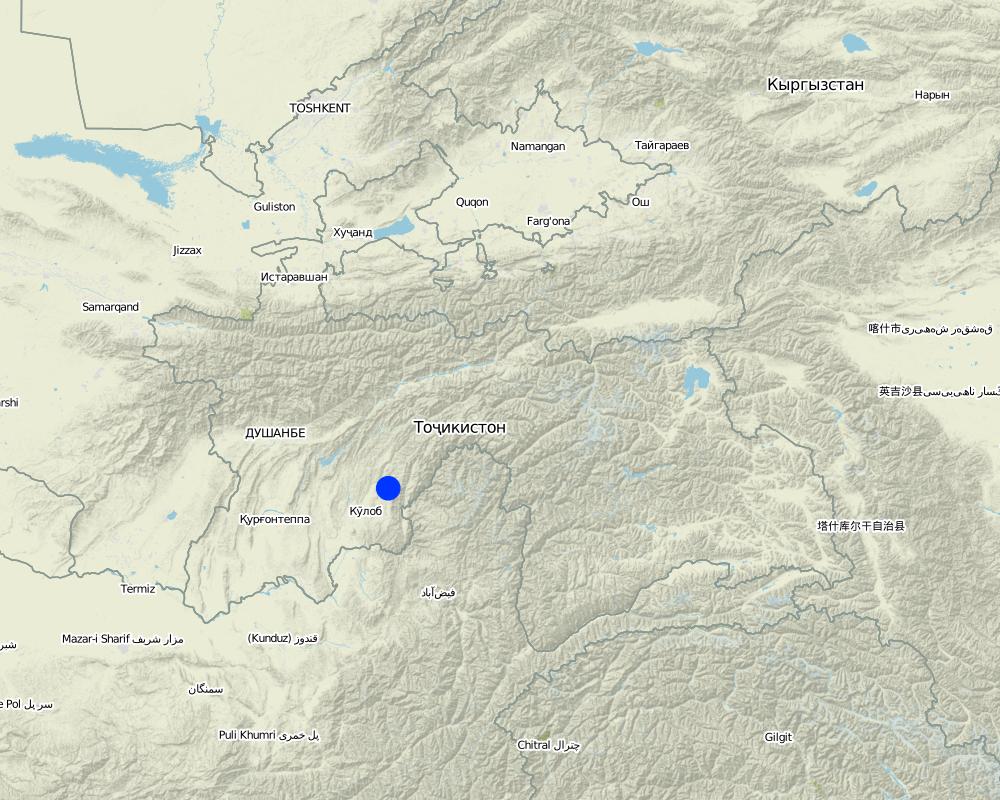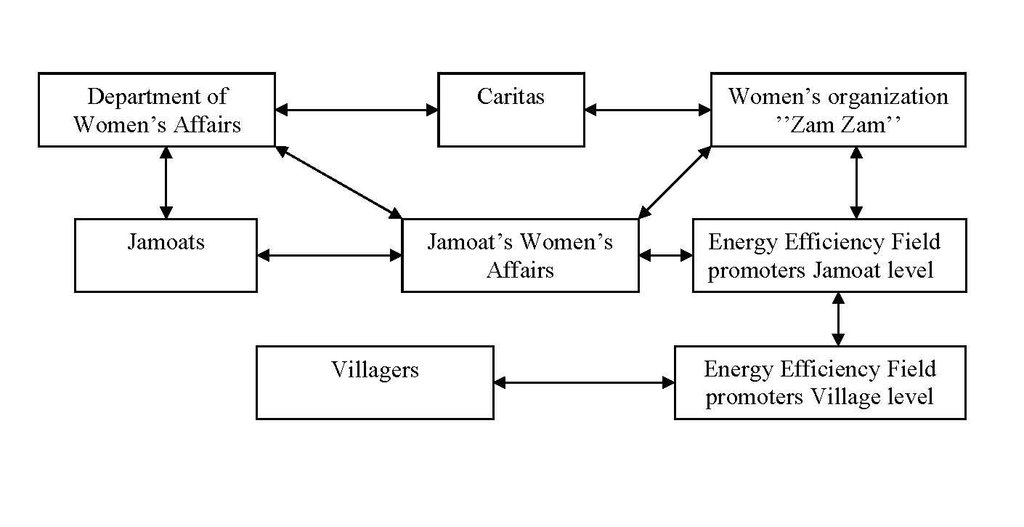Implementation through the government's Women's Affair Officers. [Tayikistán]
- Creación:
- Actualización:
- Compilador: Sa'dy Odinashoev
- Editor: –
- Revisores: David Streiff, Alexandra Gavilano
approaches_2449 - Tayikistán
Visualizar secciones
Expandir todo Colapsar todos1. Información general
1.2 Detalles de contacto de las personas de referencia e instituciones involucradas en la evaluación y la documentación del Enfoque
Especialista MST:
1.3 Condiciones referidas al uso de datos documentados mediante WOCAT
¿Cuándo se compilaron los datos (en el campo)?
06/07/2009
El compilador y la/s persona(s) de referencia claves aceptan las condiciones acerca del uso de los datos documentados mediante WOCAT :
Sí
2. Descripción del Enfoque MST
2.1 Breve descripción del Enfoque
The use of the government appointed District Womens Affair Officer to mobilise women throughout the community to implement technologies.
2.2 Descripción detallada del Enfoque MST
Descripción detallada del Enfoque MST:
Aims / objectives: The aim of the approach was to empower women through support from the government’s Women's Affairs Officer (WAO), to implement low cost energy efficient technologies within individual households. Women being the primary users of energy within the household, can become the main agents for change in applying more efficient methods to the use of natural resources to meet their cooking, heating and energy needs. Therefore, reducing fuel costs, and dependence upon local natural resources. The district local government employs a WAO, who is the government representative for women’s issues in the district. Once the WAO became supportive of the idea, she was able to engage the Women’s Affairs Officers at the Jamoat level.
Methods: This approach is fundamentally a training pyramid approach. An expert conducted a series of training sessions to interested women on the details of the technology. The training involves demonstrations of the technology, it's benefits, information on how to purchase or make the material required, and how to implement the technology. The first session is a ‘Training of Trainers’. The participants are then provided with training materials, and are invited to replicate the training in their own community. The process is continuously repeated, subsequently broadening the target audience. Zamzam, the local women’s association of the district helped suggest potential community candidates for trainers, and provided practical training sessions on energy efficiency measures through the TOT.
Stages of implementation: The implementation of the project started with an inception meeting with the District Women’s Affairs Officer to sell the idea, and to gain the local government’s support. Once she was supportive of the idea, a district level meeting was held with all the Women’s Affairs Officers at the local level (i.e. Jamoat) and two women representatives from each Jamoat. At this meeting the ladies were introduced to the technology i.e. cooking stove modification and heat exchangers. The meeting further discussed on how each jamoat would receive training, and what training materials were to be distributed to the communities. The meeting enabled issues with the technology, logistics, monitoring and overall set up of the approach to be discussed. Afterwards an expert trained a group of women from each Jamoat on the technology and provided them with materials so that the training could be repeated within their own communities.
Role of stakeholders: This is a women's led approach, the Women’s' representative within the government, who are also Women’s association members, were responsible for organisation of the trainers, logistics and government documentation support. With support from Zamzam, the active women in the community were selected as trainers to receive training from the experts and provide subsequent outreach training to their communities.
2.3 Fotos del Enfoque
2.5 País/ región/ lugares donde el Enfoque fue aplicado
País:
Tayikistán
Región/ Estado/ Provincia:
Khatlon
Especifique más el lugar :
Muminabad
Map
×2.6 Fechas de inicio y conclusión del Enfoque
Indique año del inicio:
2009
Año de conclusión (si el Enfoque ya no se aplica):
2010
2.7 Tipo de Enfoque
- governmental
2.8 Propósitos/ objetivos principales del Enfoque
The Approach focused mainly on SLM with other activities (Energy Efficiency)
The aim of the approach was to mobilise the women within the community through the use of the government appointed District Women's Affairs Officer. Once the government appointee was engaged in the promotion of the technology, she was able to use her position to mobilise the Women's Representative at the local government level (Jamoat), and subsequently women's representatives within each village level. The approach exploits the existing government's women's network to empower women to implement technologies, whilst also gaining government support and assistance.
The SLM Approach addressed the following problems: The average household in the Muminabad area uses several tonnes of tapak (dung and straw mix) and firewood each year for cooking, baking and heating. This puts excessive strain on the local natural resources, and significantly reduces the amount of organic fertiliser used in land management, as well as the removal of tree and shrubs that stabilise the land and help prevent erosion from wind, surface water run off and livestock grazing.
2.9 Condiciones que facilitan o impiden la implementación de la/s Tecnología/s aplicadas bajo el Enfoque
disponibilidad/ acceso a recursos y servicios financieros
- impiden
At the beginning women did not know that modification of the cookingstoves were not expensive, and were initially not interested in learning about the adaptation.
Treatment through the SLM Approach: Demonstration of the technolgy and explanation of the costs.
entorno institucional
- impiden
The women have been using the same style of outdoor cooking stove for many years and did not consider or were open to changing the design.
Treatment through the SLM Approach: A group workshop created an open environment in which the women could think about their energy use, their cooking equipment and discuss potential changes.
3. Participación y roles de las partes interesadas involucradas
3.1 Partes interesadas involucradas en el Enfoque y sus roles
- usuarios locales de tierras/ comunidades locales
Women's group to conduct training on the technology and women in households
The active women in the village were selected to disseminate information
- especialistas MST/consejeros agrícolas
To organise the training materials.
- gobierno local
District and local government women's affairs officers.
The entire approach was developed to engage women, as they would be the ones that would benefit most from the technology.
- organización internacional
Provided the funding and monitoring.
3.2 Involucramiento de los usuarios locales de tierras/ comunidades locales en las distintas fases del Enfoque
| Involucramiento de los usuarios locales de tierras/ comunidades locales | Especifique quién se involucró y describa las actividades | |
|---|---|---|
| iniciación/ motivación | auto-movilización | It was members of the local community that thought of the idea and approached the governments Women's Affair Officer. |
| planificación | interactivo | The local stakeholders organised a initial meeting to plan the implementation of the approach. |
| implementación | auto-movilización | Implementation was entirely through the local community, including government representatives at district and local level. |
| monitoreo y evaluación | apoyo externo | This was undertaken by the donor and at the district level. |
| Research | ninguno | None |
3.3 Flujograma (si estuviera disponible)
Descripción:
An organisational chart showing how all the organisations worked together on the project.
Autor:
Odinashoev, Sa (Muminabad, Tajikistan)
3.4 La toma de decisiones en la selección de Tecnología(s) MST
Especifique quién decidió la selección de las Tecnología/ Tecnologías a implementarse:
- principalmente usuarios de tierras con el apoyo de especialistas MST
Explique:
The idea for the approach was developed by representatives of the local community, who were interested in implementing a technology that would improve the lives of women in the community.
Decisions on the method of implementing the SLM Technology were made by mainly by SLM specialists with consultation of land users. The technology of improved cooking stoves was already developed, tried and tested, the approach orginated from already knowing which technology to implement.
4. Apoyo técnico, fortalecimiento institucional y gestión del conocimiento
4.1 Construcción de capacidades / capacitación
¿Se proporcionó la capacitación a usuarios de tierras/ otras partes interesadas?
Sí
Especifique quién fue capacitado:
- personal de campo/ consejeros
- Women's groups
Si fuese relevante, también especifique género, edad, estatus, etnicidad, etc.
The project personnel provided the initial training to the women, who in turn then trained within their own communities.
Forma de capacitación:
- de agricultor a agricultor
- áreas de demostración
Forma de capacitación:
- Training was held within the communties.
Temas avanzados:
The training was on energy efficiency measures, and how to reduce the amount of organic material used as fuel.
4.2 Servicio de asesoría
¿Los usuarios de tierras tienen acceso a un servicio de asesoría?
No
4.3 Fortalecimiento institucional (desarrollo institucional)
¿Se establecieron o fortalecieron instituciones mediante el Enfoque?
- sí, mucho
Especifique el nivel o los niveles en los que se fortalecieron o establecieron las instituciones:
- local
Especifique el tipo de apoyo:
- construcción de capacidades/ entrenamiento
Proporcione detalles adicionales:
Local NGO Zam Zam, a women's network, was used to conduct the training.
4.4 Monitoreo y evaluación
¿El monitoreo y la evaluación forman parte del Enfoque?
Sí
Comentarios:
no. of land users involved aspects were regular monitored by project staff through observations; indicators: The quality of the training was observed.
no. of land users involved aspects were regular monitored by project staff through measurements; indicators: The number of women that received training was monitored.
There were no changes in the Approach as a result of monitoring and evaluation: None
There were no changes in the Technology as a result of monitoring and evaluation: None
4.5 Investigación
¿La investigación formó parte del Enfoque?
Sí
5. Financiamiento y apoyo material externo
5.1 Presupuesto anual para el componente MST del Enfoque
Si no se conoce el presupuesto anual preciso, indique el rango:
- 2,000-10,000
Comentarios (ej. fuentes principales de financiamiento/ donantes principales):
Approach costs were met by the following donors: government (Government covered costs related to workshop for women's groups): 10.0%; international non-government (Covered the expenses such as travel and materials.): 90.0%
5.2 Apoyo financiero/material proporcionado a los usuarios de tierras
¿Los usuarios de tierras recibieron financiamiento/ apoyo material para implementar la Tecnología/ Tecnologías? :
Sí
Si respondió sí, especifique el tipo o los tipos de apoyo, condiciones y proveedor(es) :
The state provided personnel support and facilities for meetings
5.3 Subsidios para insumos específicos (incluyendo mano de obra)
- equipo
| Especifique qué insumos se subsidiaron | En qué grado | Especifique los subsidios |
|---|---|---|
| metal door | parcialmente financiado | |
- otro
| Otro (especifique) | En qué grado | Especifique los subsidios |
|---|---|---|
| transport cost | totalmente financiado | fuel, taxi |
Si la mano de obra de usuarios de tierras fue un insumo sustancial, ¿fue:
- voluntario?
Comentarios:
It is a relatively low cost approach that required traing materials, transport and demonstration equipment. The main part of the finance was required for the implementation stage of the technology, whereby half the costs were met by the land user and the rest by the donor.
5.4 Crédito
¿Se proporcionó crédito bajo el Enfoque para actividades MST?
No
6. Análisis de impacto y comentarios de conclusión
6.1 Impactos del Enfoque
¿El Enfoque ayudó a los usuarios de tierras a implementar y mantener Tecnologías MST?
- No
- Sí, un poco
- Sí, moderadamente
- Sí, mucho
The approach helped raise awareness on how to reduce the amount of organic material needed to meet the domestic fuel needs, and the saved material could be used as organic fertiliser.
¿El Enfoque empoderó a grupos en desventaja social y económica?
- No
- Sí, un poco
- Sí, moderadamente
- Sí, mucho
It improved the cooking conditions of women, and reduced their workload in the collation of natural resources to meet the household fuel needs.
¿El Enfoque mejoró cuestiones de tenencia de tierra/ derechos de usuarios que obstaculizaron la implementación de la Tecnologías MST?
- No
- Sí, un poco
- Sí, moderadamente
- Sí, mucho
Did other land users / projects adopt the Approach?
- No
- Sí, un poco
- Sí, moderadamente
- Sí, mucho
Did the Approach lead to improved livelihoods / human well-being?
- No
- Sí, un poco
- Sí, moderadamente
- Sí, mucho
The associated technology helped reduce smoke in the kitchens and a reduction in the amount of time, resources and finance that was spent on household fuel.
Did the Approach help to alleviate poverty?
- No
- Sí, un poco
- Sí, moderadamente
- Sí, mucho
It helped reduce the amount of money spent on fuel and helped preserve natural resources.
6.2 Motivación principal del usuario de la tierra para implementar MST
- incremento de la renta(bilidad), proporción mejorada de costo-beneficio
Reduce money spent on fuel.
- carga de trabajo reducida
The associated technologies helped reduce workload.
- reglas y reglamentos (multas)/ aplicación
The endorsement by the district government helped influence adoption rates.
- prestigio, presión social/ cohesión social
The approach tried to include as many women as possible, the social pressure to participate grew.
- afiliación al movimiento/ proyecto/ grupo/ redes
To a degree there was empowerment of women.
- conciencia medioambiental
Reducing the amount of smoke in the outdoor kitchen
- well-being and livelihoods improvement
Hopefully improvement in health from less smoke, less money spent on fuel and less workload.
6.3 Sostenibilidad de las actividades del Enfoque
¿Pueden los usuarios de tierras sostener lo que se implementó mediante el Enfoque (sin apoyo externo)?
- sí
Si respondió que sí, describa cómo:
The approach needs minimal finance to continue.
6.4 Fortalezas/ ventajas del Enfoque
| Fuerzas/ ventajas/ oportunidades desde la perspectiva del usuario de la tierra |
|---|
| It is easy to train a group of women, it is much harder to train men. (How to sustain/ enhance this strength: The women could benefit from further instructions on how to train. ) |
| Fuerzas/ ventajas/ oportunidades desde la perspectiva del compilador o de otra persona de referencia clave |
|---|
| The approach incorporates government support. (How to sustain/ enhance this strength: It may mean that further approaches and endorsements will have government support and generate further interest from the authorites.) |
| The approach is easy to replicate and has the potential to reach many beneficaries. (How to sustain/ enhance this strength: It could be replicated in other areas and regions. ) |
| The approach is designed specifically for the target beneficaries. (How to sustain/ enhance this strength: Other technologies that specifically benefit women could adopt this approach.) |
6.5 Debilidades/ desventajas del Enfoque y formas de sobreponerse a ellos
| Debilidades/ desventajas/ riesgos desde la perspectiva del compilador o de otra persona de referencia clave | ¿Cómo sobreponerse a ellas? |
|---|---|
| Because the approach is specifically for women it could limit the uptake by men. | Maybe subsequent training sessions could be held for men. |
| Some of the poorer households were not in a position to contribute to buying the materials or to implement the technology. This, therefore, exclused the poorest in the community. | Other memebers of the community could provide support. It should be noted that any contribution no matter how small puts a financial worth on the technology. |
7. Referencias y vínculos
7.1 Métodos/ fuentes de información
- visitas de campo, encuestas de campo
- entrevistas con usuarios de tierras
Vínculos y módulos
Expandir todo Colapsar todosVínculos
No hay vínculos
Módulos
No se hallaron módulos


